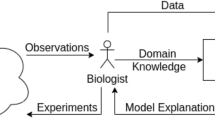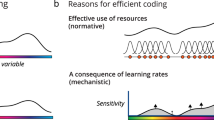Abstract
To automate the discovery of new scientific and engineering principles, artificial intelligence must distill explicit rules from experimental data. This has proven difficult because existing methods typically search through the enormous space of possible functions. Here we introduce deep distilling, a machine learning method that does not perform searches but instead learns from data using symbolic essence neural networks and then losslessly condenses the network parameters into a concise algorithm written in computer code. This distilled code, which can contain loops and nested logic, is equivalent to the neural network but is human-comprehensible and orders-of-magnitude more compact. On arithmetic, vision and optimization tasks, the distilled code is capable of out-of-distribution systematic generalization to solve cases orders-of-magnitude larger and more complex than the training data. The distilled algorithms can sometimes outperform human-designed algorithms, demonstrating that deep distilling is able to discover generalizable principles complementary to human expertise.
This is a preview of subscription content, access via your institution
Access options
Access Nature and 54 other Nature Portfolio journals
Get Nature+, our best-value online-access subscription
$29.99 / 30 days
cancel any time
Subscribe to this journal
Receive 12 digital issues and online access to articles
$99.00 per year
only $8.25 per issue
Buy this article
- Purchase on Springer Link
- Instant access to full article PDF
Prices may be subject to local taxes which are calculated during checkout




Similar content being viewed by others
Data availability
The datasets used in this work are included with the code. Source Data are provided with this paper.
Code availability
The code used to distill ENNs has been deposited at CodeOcean31 and at https://github.com/pauljblazek/deepdistilling.
References
Arrieta, A. B. et al. Explainable artificial intelligence (XAI): concepts, taxonomies, opportunities and challenges toward responsible AI. Inf. Fusion 58, 82–115 (2020).
Gunning, D. & Aha, D. DARPA’s explainable artificial intelligence (XAI) program. AI Magazine 40, 44–58 (2019).
Marcus, G. Deep learning: a critical appraisal. Preprint at http://arxiv.org/abs/1801.00631 (2018).
Chen, M. et al. Evaluating large language models trained on code. Preprint at http://arxiv.org/abs/2107.03374 (2021).
Austin, J. et al. Program synthesis with large language models. Preprint at http://arxiv.org/abs/2108.07732 (2021).
Li, Y. et al. Competition-level code generation with AlphaCode. Science 378, 1092–1097 (2022).
Zelikman, E. et al. Parsel: algorithmic reasoning with language models by composing decompositions. Preprint at http://arxiv.org/abs/2212.10561 (2023).
Romera-Paredes, B. et al. Mathematical discoveries from program search with large language models. Nature 625, 468-475 (2023).
Fawzi, A. et al. Discovering faster matrix multiplication algorithms with reinforcement learning. Nature 610, 47–53 (2022).
Gulwani, S. Automating string processing in spreadsheets using input–output examples. In POPL ’11: Proc. 38th Annual ACM SIGPLAN-SIGACT Symposium on Principles of Programming Languages Vol. 46, 317–330 (ACM, 2011).
Gulwani, S. et al. Inductive programming meets the real world. Commun. ACM 58, 90–99 (2015).
Raedt, L. D. et al. (eds) Approaches and Applications of Inductive Programming (Dagstuhl Seminar 19202) (Dagstuhl, 2019).
Kitzelmann, E. Inductive Programming: A Survey of Program Synthesis Techniques in Approaches and Applications of Inductive Programming (eds Schmid, U. et al.) 50–73 (Springer, 2010).
Balog, M., Gaunt, A. L., Brockschmidt, M., Nowozin, S. & Tarlow, D. DeepCoder: learning to write programs. In 5th Int. Conf. Learn. Represent. (2017).
Polozov, O. & Gulwani, S. FlashMeta: a framework for inductive program synthesis. In Proc. 2015 ACM SIGPLAN International Conference on Object-Oriented Programming, Systems, Languages, and Applications 107–126 (ACM, 2015).
Blazek, P. J. & Lin, M. M. Explainable neural networks that simulate reasoning. Nat. Comput. Sci. 1, 607–618 (2021).
Kautz, H. A. The third AI summer: AAAI Robert S. Engelmore memorial lecture. AI Magazine 43, 105–125 (2022).
Besold, T. R. et al. in Neuro-symbolic artificial intelligence: the state of the art. (eds Hitzler, P. & Sarker, M. K.) Ch. 1 (IOS Press, 2022).
McCulloch, W. & Pitts, W. A logical calculus of the ideas immanent in nervous activity. Bull. Math. Biophys. 5, 115–133 (1943).
Mitchell, M. in Non-standard Computation—Molecular Computation, Cellular Automata, Evolutionary Algorithms, Quantum Computers (eds Gramß, T. et al.) Ch. 4 (Wiley, 2005); https://doi.org/10.1002/3527602968.ch4
Wolfram, S. Statistical mechanics of cellular automata. Rev. Modern Phys. 55, 601–644 (1983).
Lake, B. M. & Baroni, M. Human-like systematic generalization through a meta-learning neural network. Nature 623, 115–121 (2023).
Fodor, J. A. & Pylyshyn, Z. W. Connectionism and cognitive architecture: a critical analysis. Cognition 28, 3–71 (1988).
Gardner, M. Mathematical games: the fantastic combinations of John Conway’s new solitaire game life. Scientific American 223, 120–123 (1970).
Rendell, P. A universal Turing machine in Conway’s Game of Life. In 2011 International Conference on High Performance Computing Simulation 764–772 (IEEE, 2011).
Karp, R. Reducibility among combinatorial problems. In Proc. Complexity of Computer Computations Vol. 40, 85–103 (Springer, 1972).
Poloczek, M., Schnitger, G., Williamson, D. & Zuylen, A. Greedy algorithms for the maximum satisfiability problem: simple algorithms and inapproximability bounds. SIAM J. Comput. 46, 1029–1061 (2017).
Mukhopadhyay, P. & Chaudhuri, B. B. A survey of Hough transform. Pattern Recognition 48, 993–1010 (2015).
Adams, G. S., Converse, B. A., Hales, A. H. & Klotz, L. E. People systematically overlook subtractive changes. Nature 592, 258–261 (2021).
McCluskey, E. J. Minimization of Boolean functions. Bell Syst. Tech. J. 35, 1417–1444 (1956).
Blazek, P. B. & Lin, M. M. Deep distilling: automated algorithm discovery using explainable deep learning. Code Ocean https://doi.org/10.24433/CO.6047170.v1 (2024).
Acknowledgements
This work was supported by the UTSW High Risk/High Impact grant.
Author information
Authors and Affiliations
Contributions
P.J.B. and M.M.L. conceptualized the work, wrote the paper, and performed the visualizations and methodology. M.M.L. acquired funding. P.J.B. and K.V. performed investigations and co-wrote the software.
Corresponding author
Ethics declarations
Competing interests
P.J.B. and M.M.L. are co-authors on international patent applications related to ENNs (PCT/US2021/019470) and to deep distilling (PCT/US2022/040885). K.V. declares no competing interests.
Peer review
Peer review information
Nature Computational Science thanks Joseph Bakarji and the other, anonymous, reviewer(s) for their contribution to the peer review of this work. Primary Handling Editor: Ananya Rastogi, in collaboration with the Nature Computational Science team.
Additional information
Publisher’s note Springer Nature remains neutral with regard to jurisdictional claims in published maps and institutional affiliations.
Supplementary information
Supplementary Information
Supplementary Figs. 1–4, discussion and examples of output code generated by the method described.
Source data
Source Data Fig. 2
Source data files (.csv).
Source Data Fig. 4
Source data files (.csv).
Rights and permissions
Springer Nature or its licensor (e.g. a society or other partner) holds exclusive rights to this article under a publishing agreement with the author(s) or other rightsholder(s); author self-archiving of the accepted manuscript version of this article is solely governed by the terms of such publishing agreement and applicable law.
About this article
Cite this article
Blazek, P.J., Venkatesh, K. & Lin, M.M. Automated discovery of algorithms from data. Nat Comput Sci 4, 110–118 (2024). https://doi.org/10.1038/s43588-024-00593-9
Received:
Accepted:
Published:
Issue Date:
DOI: https://doi.org/10.1038/s43588-024-00593-9
This article is cited by
-
Distilling data into code
Nature Computational Science (2024)



